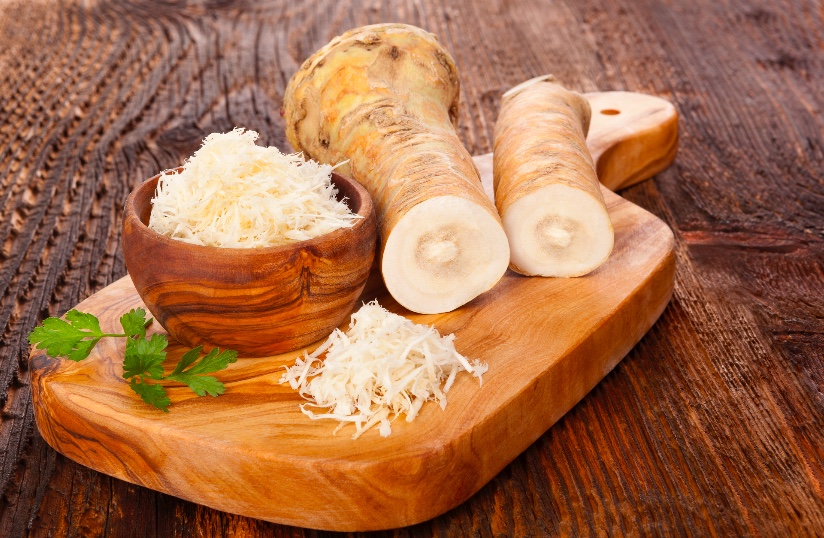Our resident gardening and food writer Hans Wieland shares the secrets of horseradishes in this extract from our Summer 2018 issue.

Horseradish, a Vegetable to Cry For
Growing vegetables that make a difference
By Hans Wieland
I have been living with horseradish all my life – in fact, even before my life, as the wedding dish of my parents was beef in horseradish cream sauce with potatoes, considered a poor man’s dish in the 50s, but with an outstanding flavour, as my late mum claimed.
Horseradish is a hardy root crop, an often neglected group of nutritious vegetables, which are most useful during the winter months. In German, it’s called “Meerrettich” (sea radish) because it grows best by the sea. Many believe the English mispronounced the German word “Meer” and began calling it “mareradish.” Eventually it became known as horseradish. In my humble view, horseradish is one of those plants that can transform dishes.
How to grow horseradish…
My parents did not live by the sea. They grew their horseradish beside the compost heap, probably with no other intention than to give it enough space. The main culinary use at home was for sauces, to be grated and mixed with freshly made quark, and also as a source of Vitamin C in my mum’s winter tonic of horseradish, onions and garlic.
Horseradish is a vigorous perennial plant from the Cabbage family (brassica), which also includes mustard, wasabi and broccoli. It can grow up to one metre tall and develops long stout roots. As a root vegetable, it is cultivated primarily for its large, white, tapered root, and also used as a spice. The plant is probably native to south eastern Europe and western Asia, but has a place in most Middle European gardens.
It grows better roots for harvesting if given its own space and attention. A rich fertile soil would be great. Being a deep root crop, it needs depth to grow, so a hard subsoil won’t be to its liking. But in the wide area between these extremes, which is pretty much any healthy garden soil, it will give you a good crop with very little effort.
We grow horseradish at Neantóg in true family tradition, beside our compost heap where its spreading habit doesn’t become a problem. In a herb garden, it can be grown in a big and deep container: a half barrel, for example. It’s a large-leafed, tall perennial plant, so make sure it won’t be overpowering a more delicate neighbour.
Horseradish is best grown from a root cutting – similar to comfrey – or start with a potted plant from a good garden centre. In year one, I recommend growing it in a big, tall pot to boost growth without harvesting. In year two it can be planted in its final position.
…and harvest
After the first frost in autumn kills the leaves, the root can be dug and divided. The main root is harvested and one or more large offshoots of the main root are replanted to produce next year’s crop. Horseradish left undisturbed in the garden spreads via underground shoots and can become invasive. Older roots left in the ground become woody, after which they are no longer culinarily useful, though older plants can be dug and re-divided to start new plants. The early season leaves can be distinctively different: asymmetric and spiky, before the mature typical flat broad leaves start to be developed.
The culinary use of horseradish
The intact horseradish root has hardly any aroma, but when cut or grated, enzymes from the now broken plant cells break down the sugars to produce mustard oil, which can irritate the mucous membranes of the sinuses and eyes. Once exposed to air or heat, it will begin to lose its pungency, darken in colour, and become unpleasantly bitter tasting over time.
The mustard oil (allyl isothiocyanate) serves the plant as a natural defence against herbivores. When an animal chews the plant, the mustard oil is released, repelling the animal. The health benefits of horseradish are manifold: a very high Vitamin C content, antibiotic properties and beneficial for blood circulation. Homemade remedies are more potent than bought ones. Chefs often use the grated root of the horseradish plant mixed with vinegar, which they call “prepared horseradish”. Preserved like that, it can be stored for months under refrigeration, but eventually it will darken, indicating it is losing flavour and should be replaced. The leaves of the plant or “horseradish greens” – while edible – are not commonly eaten, because of their very strong flavour.
The preferred use of horseradish in the Wieland household, besides being an ingredient in Gaby’s master tonic, is mixing it with quark, soft cheeses or ricotta. Here is a very simple recipe:
Horseradish quark
500g of fresh quark or soft cheese
3-4 tablespoons of freshly grated horseradish
1 apple grated, lemon juice, salt and pepper to season
Hans Wieland worked and taught at the Organic Centre for over 20 years before ‘retiring’ to Neantóg Kitchen Garden School in Cliffoney this May, along with his wife Gaby Wieland, herbalist and naturopath. The couple offer a range of courses and workshops in food growing, fermenting, foraging, cheese making, healthy cooking and baking.


